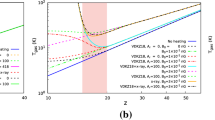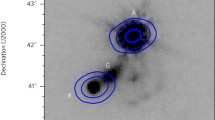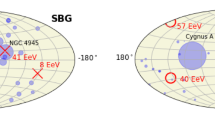Abstract
Magnetic fields occupying the voids of the large scale structure may be a relic from the Early Universe originating from either Inflation or from cosmological phase transitions. We explore the possibility of identifying the inflationary origin of the void magnetic fields and measuring its parameters with γ-ray astronomy methods. The large correlation length inflationary field is expected to impose a characteristic asymmetry of extended γ-ray emission that is correlated between different sources on the sky. We show that a set of nearby blazars for which the extended emission is observable in the 0.1–1 TeV band with CTA can be used for the test of inflationary origin of the void magnetic fields.






Similar content being viewed by others
Notes
The “analysis caveats” page of Fermi Science Support Center, https://fermi.gsfc.nasa.gov/ssc/data/analysis/caveats.html recommends the use of Fermi/LAT spectra up to 1 TeV, because of the lack of validation of the Instrument Response Functions (IRFs) in the 1–3 TeV energy range. Our comparison of Fermi/LAT and Cherenkov telescope spectra of bright blazars shown in Fig. 6 shows that the Fermi/LAT measurements in this energy range agree with those of other γ-ray telescopes.
REFERENCES
R. Plaga, Nature (London, U.K.) 374, 430 (1995).
A. Neronov and D. V. Semikoz, JETP Lett. 85, 473 (2007).
A. Neronov and D. Semikoz, Phys. Rev. D 80, 123012 (2009); arXiv: 0910.1920.
A. Neronov and I. Vovk, Science (Washington, DC, U. S.) 328, 73 (2010); arXiv: 1006.3504.
A. Taylor, I. Vovk, and A. Neronov, Astron. Astrophys. 529, A144 (2011).
M. Ackermann et al. (Fermi-LAT), Astrophys. J. Suppl. 237, 32 (2018).
A. Korochkin, O. Kalashev, A. Neronov, and D. Semikoz, Astrophys. J. 906, 116 (2021).
I. Vovk, J. Biteau, H. Martínez-Huerta, M. Meyer, and S. Pita (CTA Consortium), PoS ICRC 2021, 894 (2021).
R. Banerjee and K. Jedamzik, Phys. Rev. D 70, 123003 (2004).
T. Kahniashvili, A. G. Tevzadze, A. Brandenburg, and A. Neronov, Phys. Rev. D 87, 083007 (2013).
M. S. Turner and L. M. Widrow, Phys. Rev. D 37, 2743 (1988).
B. Ratra, Astrophys. J. Lett. 391, L1 (1992).
W. D. Garretson, G. B. Field, and S. M. Carroll, Phys. Rev. D 46, 5346 (1992).
A. D. Dolgov, Phys. Rev. D 48, 2499 (1993).
M. Gasperini, M. Giovannini, and G. Veneziano, Phys. Rev. Lett. 75, 3796 (1995).
M. Giovannini and M. E. Shaposhnikov, Phys. Rev. D 62, 103512 (2000).
V. Demozzi, V. Mukhanov, and H. Rubinstein, J. Cosmol. Astropart. Phys., No. 08, 025 (2009).
R. J. Z. Ferreira, R. K. Jain, and M. S. Sloth, J. Cosmol. Astropart. Phys., No. 10, 004 (2013).
R. Durrer and A. Neronov, Astron. Astrophys. Rev. 21, 62 (2013).
S. Bertone, C. Vogt, and T. Ensslin, Mon. Not. R. Astron. Soc. 370, 319 (2006).
F. Marinacci, M. Vogelsberger, R. Pakmor, P. Torrey, V. Springel, L. Hernquist, D. Nelson, R. Weinberger, A. Pillepich, J. Naiman, et al., Mon. Not. R. Astron. Soc. 480, 5113 (2018).
K. Bondarenko, A. Boyarsky, A. Korochkin, A. Neronov, D. Semikoz, and A. Sokolenko, arXiv: 2106.02690 (2021).
J. Jasche and B. D. Wandelt, Mon. Not. R. Astron. Soc. 432, 894 (2013).
R. Teyssier, Astron. Astrophys. 385, 337 (2002).
V. Berezinsky and O. Kalashev, Phys. Rev. D 94, 023007 (2016).
S. Fromang, P. Hennebelle, and R. Teyssier, in Proceedings of the SF2A-2005: Semaine de l’Astrophysique Francaise (2005), p. 743.
J. Jasche and G. Lavaux, Astron. Astrophys. 625, A64 (2019).
G. Lavaux and M. J. Hudson, Mon. Not. R. Astron. Soc. 416, 2840 (2011); arXiv: 1105.6107.
O. Hahn and T. Abel, Mon. Not. R. Astron. Soc. 415, 2101 (2011).
T. Miyoshi and K. Kusano, J. Comput. Phys. 208, 315 (2005).
K. Bondarenko, J. Pradler, and A. Sokolenko, Phys. Lett. B 805, 135420 (2020).
C. R. Evans and J. F. Hawley, Astrophys. J. 332, 659 (1988).
F. A. Stasyszyn and D. Elstner, J. Comput. Phys. 282, 148 (2015).
P. Mocz, R. Pakmor, V. Springel, M. Vogelsberger, F. Marinacci, and L. Hernquist, Mon. Not. R. Astron. Soc. 463, 477 (2016).
A. Franceschini, G. Rodighiero, and M. Vaccari, Astron. Astrophys. 487, 837 (2008).
A. Neronov, D. Semikoz, M. Kachelriess, S. Ostapchenko, and A. Elyiv, Astrophys. J. Lett. 719, L130 (2010).
A. A. Abdo et al. (LAT, MAGIC, VERITAS), Astrophys. J. 727, 129 (2011).
B. e. a. A. Bartoli, Astrophys. J. 758, 2 (2012).
S. Coutiño de Leon, A. C. Alonso, D. Rosa-Gonzalez, and A. L. Longinotti, in Proceedings of the 36th International Cosmic Ray Conference ICRC'2019 (2019), vol. 36, p. 654.
S. Abdollahi et al. (Fermi-LAT), Astrophys. J. Suppl. 247, 33 (2020).
B. Bartoli et al. (ARGO-YBJ), Astrophys. J. Suppl. 222, 6 (2016).
V. A. Acciari et al., Astrophys. J. 738, 25 (2011).
A. Neronov, D. V. Semikoz, P. G. Tinyakov, and I. I. Tkachev, Astron. Astrophys. 526, A90 (2011).
P. da Vela, A. Stamerra, A. Neronov, E. Prandini, Y. Konno, and J. Sitarek, Astropart. Phys. 98, 1 (2018).
ACKNOWLEDGMENTS
The work of A.N., G.L., M.R., and D.S. has been supported in part by the French National Research Agency (ANR) grant ANR-19-CE31-0020, work of A.K. was supported in part by Russian Science Foundation grant 20-42-09010. A.K.’s stay in the APC laboratory was provided by the “Vernadsky” scholarship of the French embassy in Russia. This work has made use of the Infinity Cluster hosted by Institut d’Astrophysique de Paris. We thank Stéphane Rouberol for running this cluster smoothly for us. This work has been done within the Aquila Consortium (https://www.aquila-consortium.org).
Author information
Authors and Affiliations
Corresponding author
Ethics declarations
The authors declare that they have no conflicts of interest.
Additional information
This article was written for the special JETP issue dedicated to centenary of A.E. Chudakov
Rights and permissions
About this article
Cite this article
Korochkin, A., Neronov, A., Lavaux, G. et al. Detectability of Large Correlation Length Inflationary Magnetic Field with Cherenkov Telescopes. J. Exp. Theor. Phys. 134, 498–505 (2022). https://doi.org/10.1134/S1063776122040057
Received:
Revised:
Accepted:
Published:
Issue Date:
DOI: https://doi.org/10.1134/S1063776122040057




